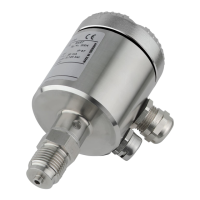18 IM/261Gx/Ax-EN Rev. 08 | 261Gx, 261Ax
Change from one to two colu mns
5.3.1 Assembly and connection of Han 8D (8U) socket
connector
The socket connector for connecting the cable is supplied
unassembled as an accessory for the transmitter.
IMPORTANT (NOTICE)
Please observe the specifications for the electrical
connection that have been supplied with the
connector.
Assembly is depicted in the figure below.
Fig. 10: Assembling the socket connector
1 Socket | 2 Contact | 3 Socket shell |
4 Gasket (can be cut) | 5 Thrust collar |
6 PG 11 pressure screw |
7 Cable (diameter 5 … 11 mm (0.20 ... 0.43 inch))
1. The contacts are crimped or soldered onto the cable ends
(wire cross-section of 0.75 … 1 mm
2
(AWG 18 … AWG
17)), from which approx. 1.5 … 2 cm (0.59 … 0.79 inch)
of the sleeve and approx. 8 mm (0.32 inch) of the
insulation have been stripped; they are then inserted into
the socket from the rear.
2. Slide the pressure screw, thrust collar, gasket, and socket
shell onto the cable in the order indicated before assembly
(you may have to adjust the gasket to fit the cable
diameter).
5.4 Protective conductor/Grounding (optional)
A terminal is available on the outside of the housing for
grounding (PE) the transmitter.
5.5 Communication setup
The transmitter can be operated via a modem, using a PC or
laptop. The modem can be connected to the transmitter in
parallel at any point in the signal circuit. Communication
between transmitter and modem occurs via AC signals that
are superimposed on the analog 4 ... 20 mA output signal.
This modulation occurs without averaging and does not,
therefore, affect the measuring signal.
Communication between transmitter and PC or laptop is only
possible if the signal circuit is set up as shown in the following
figure, “Communication mode: Point-to-point”. The resistance
between the connecting point for the FSK modem and the
power supply must be at least 250 Ω (including internal
resistance of the power supply unit). If this value is not
achieved within the context of normal installation, an additional
resistor must be used.
The ABB Contrans I supply modules with HART
communication already have a factory-installed, additional
resistor. Some of these modules offer the option of
communicating directly over the supply module in the
operating mode "FSK bus".
Power can be supplied by power supply units, batteries, or
power supplies; these must be designed to ensure that the
operating voltage UB of the transmitter always remains
between DC 11 V and 42 V (30 V for "Ex i").
In addition, the maximum current of 20 … 23.6 mA resulting
from overranging must be considered, depending on the
corresponding parameterization. This yields the minimum
value for US.
If additional signal receivers (e.g., indicators) are looped into
the signal circuit, their resistance must also be considered.

